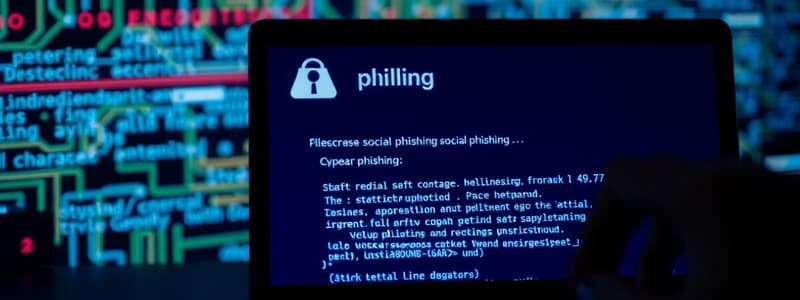Podcast
Questions and Answers
Which method is NOT commonly used for spear phishing?
Which method is NOT commonly used for spear phishing?
- Social media advertising (correct)
- Carrier pigeon
- Snail mail
What is the ultimate goal of spear phishing?
What is the ultimate goal of spear phishing?
- To send spam messages
- To compromise personal computers (correct)
- To create a malware-free network
- To gather general information
Which of the following is a method included in the spear-phishing tactics?
Which of the following is a method included in the spear-phishing tactics?
- Mass email campaigns
- Public forums
- Client-side exploits (correct)
- Fast information gathering
How should one approach social engineering during spear phishing?
How should one approach social engineering during spear phishing?
What type of interaction helps increase the success of social engineering in spear phishing?
What type of interaction helps increase the success of social engineering in spear phishing?
What is a primary consideration when building a story for phishing?
What is a primary consideration when building a story for phishing?
Which tactic is commonly used in spear-phishing attacks related to websites?
Which tactic is commonly used in spear-phishing attacks related to websites?
What is a potential issue when copying an existing website for phishing purposes?
What is a potential issue when copying an existing website for phishing purposes?
What is a recommended approach after copying a website for phishing?
What is a recommended approach after copying a website for phishing?
Which example of a story would be effective in a phishing context?
Which example of a story would be effective in a phishing context?
What is an important factor to consider when creating a phishing website's appearance?
What is an important factor to consider when creating a phishing website's appearance?
What technique is suggested to register a domain name that is related to an established website?
What technique is suggested to register a domain name that is related to an established website?
Which of the following is NOT a recommended domain naming strategy for phishing?
Which of the following is NOT a recommended domain naming strategy for phishing?
What advantage does registering your own domain name provide for phishing activities?
What advantage does registering your own domain name provide for phishing activities?
What should be implemented on the back end of a phishing website after designing its front end?
What should be implemented on the back end of a phishing website after designing its front end?
A phishing website should look familiar to users to avoid suspicion.
A phishing website should look familiar to users to avoid suspicion.
A domain name that uses a capital 'I' instead of a lowercase 'l' is a common technique for phishing.
A domain name that uses a capital 'I' instead of a lowercase 'l' is a common technique for phishing.
Using SSL certificates is crucial for phishing websites to appear legitimate.
Using SSL certificates is crucial for phishing websites to appear legitimate.
One strategy for phishing is to choose a domain that is entirely different from the target's.
One strategy for phishing is to choose a domain that is entirely different from the target's.
Implementing proper back-end functionality is not necessary for phishing websites.
Implementing proper back-end functionality is not necessary for phishing websites.
A successful phishing website must look exactly like the legitimate website.
A successful phishing website must look exactly like the legitimate website.
Cascading Style Sheet (CSS) files are often excluded when copying a website for phishing purposes.
Cascading Style Sheet (CSS) files are often excluded when copying a website for phishing purposes.
Phishing tactics do not require a story to elicit a response from the target user.
Phishing tactics do not require a story to elicit a response from the target user.
The Social Engineering Toolkit can be used to automate the process of copying existing websites.
The Social Engineering Toolkit can be used to automate the process of copying existing websites.
Testing the appearance of the cloned website is unnecessary after copying it for phishing.
Testing the appearance of the cloned website is unnecessary after copying it for phishing.
E-mail is the only effective weapon for spear phishing.
E-mail is the only effective weapon for spear phishing.
Carrier pigeon can be used as a method of spear phishing.
Carrier pigeon can be used as a method of spear phishing.
The ultimate goal of spear phishing is to compromise a target individual's computer.
The ultimate goal of spear phishing is to compromise a target individual's computer.
Building trust with the target user does not affect the success of spear phishing.
Building trust with the target user does not affect the success of spear phishing.
Post-It notes are a recommended method for spear phishing.
Post-It notes are a recommended method for spear phishing.
Flashcards
Effective Phishing Story
Effective Phishing Story
A story tailored to a specific user that encourages them to interact with a phishing website or install software.
Phishing Website Tactics
Phishing Website Tactics
Techniques for creating a fraudulent website that mimics a legitimate one to trick users into sharing credentials.
Website Copying Tools
Website Copying Tools
Software used to automatically replicate existing websites for phishing attacks.
Missing Files/Testing
Missing Files/Testing
Signup and view all the flashcards
Website Functionality
Website Functionality
Signup and view all the flashcards
Spear Phishing Methods
Spear Phishing Methods
Signup and view all the flashcards
Spear Phishing Goal
Spear Phishing Goal
Signup and view all the flashcards
Technical Spear Phishing Tactics
Technical Spear Phishing Tactics
Signup and view all the flashcards
Building Trust in Spear Phishing
Building Trust in Spear Phishing
Signup and view all the flashcards
Target in Spear Phishing
Target in Spear Phishing
Signup and view all the flashcards
Phishing Website Look & Feel
Phishing Website Look & Feel
Signup and view all the flashcards
Phishing Domain Name
Phishing Domain Name
Signup and view all the flashcards
Subtle Misspellings
Subtle Misspellings
Signup and view all the flashcards
Secondary Domains
Secondary Domains
Signup and view all the flashcards
Back-End Functionality
Back-End Functionality
Signup and view all the flashcards
Technical Spear Phishing Exploitations
Technical Spear Phishing Exploitations
Signup and view all the flashcards
Spear Phishing Tactics
Spear Phishing Tactics
Signup and view all the flashcards
Why is building a good story important?
Why is building a good story important?
Signup and view all the flashcards
What are good phishing stories?
What are good phishing stories?
Signup and view all the flashcards
What's the purpose of copying a website?
What's the purpose of copying a website?
Signup and view all the flashcards
What are missing files?
What are missing files?
Signup and view all the flashcards
Why is testing a phishing site important?
Why is testing a phishing site important?
Signup and view all the flashcards
Domain Name Mimicry
Domain Name Mimicry
Signup and view all the flashcards
Website Look & Feel
Website Look & Feel
Signup and view all the flashcards
Study Notes
Spear Social Engineering - Part 2
- Spear phishing is a targeted attack, not just sending spam emails.
- Spear phishing aims to compromise a target's computer and obtain their credentials to access important applications like banking portals, not just emails.
- Attackers use various methods beyond email, such as snail mail, phone calls, text messaging (e.g., Twitter, Facebook), instant messaging, watering hole websites, malicious websites, CB radio, walkie-talkies, and even carrier pigeons.
- While these methods might seem unusual, some companies use them for internal communication, making them appear trustworthy and vulnerable to attack.
- Social engineering tactics involve building trust with the target.
Spear Phishing Methods
- Email, snail mail, phone calls, text messaging, and instant messaging (Twitter, Facebook) are employed.
- Attackers may use watering hole websites, malicious websites, CB radio, walkie-talkies, Post-it notes, or even carrier pigeons.
- Email spear phishing is an effective tactic but not the only one.
Spear Phishing Goal
- The goal is to compromise the target computer and obtain credentials for important applications.
- Main exploitation methods include phishing websites to obtain credentials, client-side exploits, and custom Trojan backdoors.
Technical Spear Phishing Tactics
-
Tactics apply to various exploitation methods, but attackers should avoid targeting too many people at once, as this could raise suspicion.
-
They aim to have more interaction to build trust by interacting with the target under a false guise.
-
This interaction builds on reconnaissance (gathering information about the target).
-
Collecting as much technical and non-technical information about the target is vital.
Building the Story
- Craft a believable story to establish a rapport with the target.
- Ignore conventions; think outside the box when crafting stories.
- Determine the most impactful and accurate story for each target.
Examples of Effective Stories
- A partner, sister company, or parent company offering trial software
- An internal salesperson providing a free trial
- Inviting interest in a common hobby or interest group
- A product feedback request (e.g., software trial) for their industry.
Phishing Website Tactics
- The traditional method involves copying a legitimate website and directing the target to the fraudulent site.
- The fraudulent site should mimic the legitimate one, including triggers (e.g., legitimate look, feel, and functionality).
- Tools like the Social Engineering Toolkit (SET) Site Cloner automatically copy existing websites.
- Configuring the tool to harvest credentials is essential.
- Missing dependent files (like CSS or JavaScript) require checking and inclusion for a complete phishing website.
- Thorough testing (visual and functional) is critical.
Website Look and Feel
- The website must convincingly mimic the authentic website to avoid suspicion.
- Maintain familiar visual elements, down to the font, for maximum effect.
- Understand the target's expectations to create a believable and successful phishing operation.
Website: Domain Name Options
- Choose a domain name that won't raise immediate suspicion from the target.
- Create a new company or subtly alter an existing one's domain name (e.g., using a misspelling or adding extra characters).
Website: Domain Name Example
- If a target's domain is
weaktarget.com, consider registeringportal-weaktarget.com,benefit-weaktarget.com,login-weaktarget.com, orwww-weaktarget.com. - Register a domain name that is similar to the legitimate one (e.g.,
Softwarex0.com).
Phishing Website: Back-End Functionality
- Implement the proper features on the backend (e.g., user login forms).
- Select a suitable back-end language (e.g., PHP).
- Set up for user login (username and password fields; file storage for data).
- Credentials need storage in a file (e.g., .txt).
- Capture not just usernames and passwords but also IP addresses.
- Give users options after they log in.
Phishing Website: Back-End Functionality Alternatives
- Redirect users to a legitimate or "static" page on the attacker's website.
- Redirect users to a malware deployment page.
- Act as a proxy between the target and the genuine website, while logging all activity.
Phishing Website: Watering Holes
- Watering holes are common sites visited by a target user.
- Focus on building a site that targets the specific user's industry.
- The site gives users the illusion of a public or private forum to join.
Client-Side Exploit
- Attacks target vulnerabilities in endpoint software (like workstations).
- Popular software targets include office productivity suites, email clients, and multimedia software (e.g., Microsoft Word, Excel, Adobe Acrobat, browsers).
Custom Trojan Backdoor
- Custom Trojan backdoors are very efficient for deployment.
- The backdoor software can be bundled with pirated or trial software from legitimate vendors.
- Direct delivery to the target can be accomplished via websites, public file-sharing sites, or physical media (like CDs, USB drives).
Studying That Suits You
Use AI to generate personalized quizzes and flashcards to suit your learning preferences.




